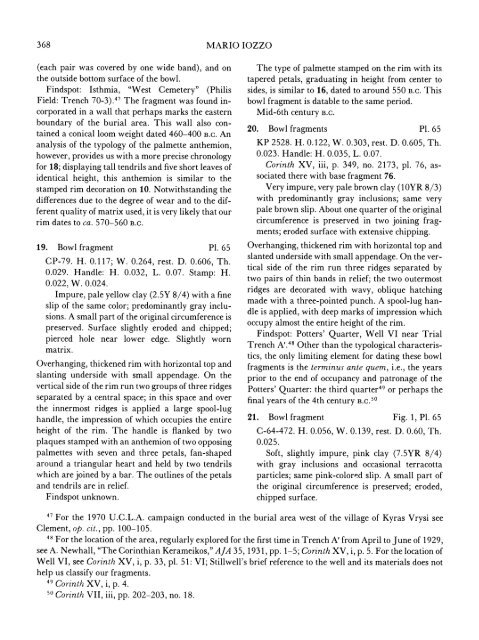f - The American School of Classical Studies at Athens
f - The American School of Classical Studies at Athens
f - The American School of Classical Studies at Athens
Create successful ePaper yourself
Turn your PDF publications into a flip-book with our unique Google optimized e-Paper software.
368 MARIO IOZZO<br />
(each pair was covered by one wide band), and on<br />
the outside bottom surface <strong>of</strong> the bowl.<br />
Findspot: Isthmia, "West Cemetery" (Philis<br />
Field: Trench 70-3).47 <strong>The</strong> fragment was found in-<br />
corpor<strong>at</strong>ed in a wall th<strong>at</strong> perhaps marks the eastern<br />
boundary <strong>of</strong> the burial area. This wall also con-<br />
tained a conical loom weight d<strong>at</strong>ed 460-400 B.C. An<br />
analysis <strong>of</strong> the typology <strong>of</strong> the palmette anthemion,<br />
however, provides us with a more precise chronology<br />
for 18; displaying tall tendrils and five short leaves <strong>of</strong><br />
identical height, this anthemion is similar to the<br />
stamped rim decor<strong>at</strong>ion on 10. Notwithstanding the<br />
differences due to the degree <strong>of</strong> wear and to the dif-<br />
ferent quality <strong>of</strong> m<strong>at</strong>rix used, it is very likely th<strong>at</strong> our<br />
rim d<strong>at</strong>es to ca. 570-560 B.C.<br />
19. Bowl fragment P1. 65<br />
CP-79. H. 0.117; W. 0.264, rest. D. 0.606, Th.<br />
0.029. Handle: H. 0.032, L. 0.07. Stamp: H.<br />
0.022, W. 0.024.<br />
Impure, pale yellow clay (2.5Y 8/4) with a fine<br />
slip <strong>of</strong> the same color; predominantly gray inclusions.<br />
A small part <strong>of</strong> the original circumference is<br />
preserved. Surface slightly eroded and chipped;<br />
pierced hole near lower edge. Slightly worn<br />
m<strong>at</strong>rix.<br />
Overhanging, thickened rim with horizontal top and<br />
slanting underside with small appendage. On the<br />
vertical side <strong>of</strong> the rim run two groups <strong>of</strong> three ridges<br />
separ<strong>at</strong>ed by a central space; in this space and over<br />
the innermost ridges is applied a large spool-lug<br />
handle, the impression <strong>of</strong> which occupies the entire<br />
height <strong>of</strong> the rim. <strong>The</strong> handle is flanked by two<br />
plaques stamped with an anthemion <strong>of</strong> two opposing<br />
palmettes with seven and three petals, fan-shaped<br />
around a triangular heart and held by two tendrils<br />
which are joined by a bar. <strong>The</strong> outlines <strong>of</strong> the petals<br />
and tendrils are in relief.<br />
Findspot unknown.<br />
<strong>The</strong> type <strong>of</strong> palmette stamped on the rim with its<br />
tapered petals, gradu<strong>at</strong>ing in height from center to<br />
sides, is similar to 16, d<strong>at</strong>ed to around 550 B.C. This<br />
bowl fragment is d<strong>at</strong>able to the same period.<br />
Mid-6th century B.C.<br />
20. Bowl fragments P1. 65<br />
KP 2528. H. 0.122, W. 0.303, rest. D. 0.605, Th.<br />
0.023. Handle: H. 0.035, L. 0.07.<br />
Corinth XV, iii, p. 349, no. 2173, pl. 76, as-<br />
soci<strong>at</strong>ed there with base fragment 76.<br />
Very impure, very pale brown clay (1OYR 8/3)<br />
with predominantly gray inclusions; same very<br />
pale brown slip. About one quarter <strong>of</strong> the original<br />
circumference is preserved in two joining frag-<br />
ments; eroded surface with extensive chipping.<br />
Overhanging, thickened rim with horizontal top and<br />
slanted underside with small appendage. On the ver-<br />
tical side <strong>of</strong> the rim run three ridges separ<strong>at</strong>ed by<br />
two pairs <strong>of</strong> thin bands in relief; the two outermost<br />
ridges are decor<strong>at</strong>ed with wavy, oblique h<strong>at</strong>ching<br />
made with a three-pointed punch. A spool-lug han-<br />
dle is applied, with deep marks <strong>of</strong> impression which<br />
occupy almost the entire height <strong>of</strong> the rim.<br />
Findspot: Potters' Quarter, Well VI near Trial<br />
Trench A'.48 Other than the typological characteris-<br />
tics, the only limiting element for d<strong>at</strong>ing these bowl<br />
fragments is the terminus ante quem, i.e., the years<br />
prior to the end <strong>of</strong> occupancy and p<strong>at</strong>ronage <strong>of</strong> the<br />
Potters' Quarter: the third quarter49 or perhaps the<br />
final years <strong>of</strong> the 4th century B.C.50<br />
21. Bowl fragment Fig. 1, P1. 65<br />
C-64-472. H. 0.056, W. 0.139, rest. D. 0.60, Th.<br />
0.025.<br />
S<strong>of</strong>t, slightly impure, pink clay (7.5YR 8/4)<br />
with gray inclusions and occasional terracotta<br />
particles; same pink-colore~d slip. A small part <strong>of</strong><br />
the original circumference is preserved; eroded,<br />
chipped surface.<br />
4 For the 1970 U.C.L.A. campaign conducted in the burial area west <strong>of</strong> the village <strong>of</strong> Kyras Vrysi see<br />
Clement, op. cit., pp. 100-105.<br />
48 For the loc<strong>at</strong>ion <strong>of</strong> the area, regularly explored for the first time in Trench A' from April to June <strong>of</strong> 1929,<br />
see A. Newhall, "<strong>The</strong> Corinthian Kerameikos," AJA 35,1931, pp. 1-5; Corinth XV, i, p. 5. For the loc<strong>at</strong>ion <strong>of</strong><br />
Well VI, see Corinth XV, i, p. 33, pl. 51: VI; Stillwell's brief reference to the well and its m<strong>at</strong>erials does not<br />
help us classify our fragments.<br />
4 Corinth XV, i, p. 4.<br />
50 Corinth VII, iii, pp. 202-203, no. 18.

















